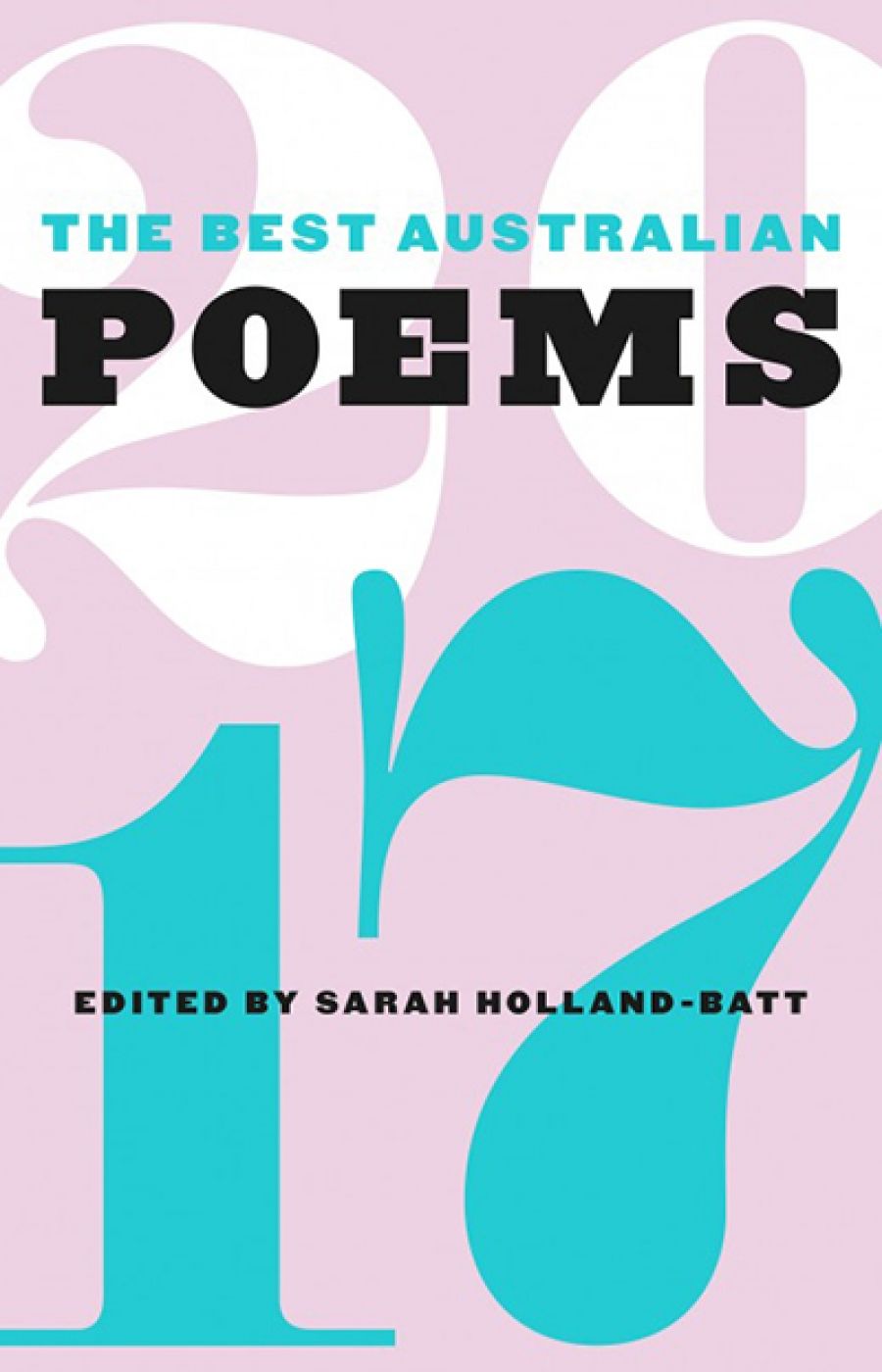
- Free Article: No
- Contents Category: Poetry
- Custom Article Title: Gregory Day reviews 'The Best Australian Poems 2017' edited by Sarah Holland-Batt
- Review Article: Yes
- Online Only: No
- Custom Highlight Text:
When W.H. Auden took the cue for his poem ‘Musée des Beaux Arts’ from Brueghel’s Fall of Icarus, he did not presume the reader’s knowledge of the iconography of the painting but rather sprang open its central and universal theme, which touches all our lives: how ‘dreadful martyrdom must run its course’. It is easy to think our lurid times are perhaps ...
- Book 1 Title: The Best Australian Poems 2017
- Book 1 Biblio: Black Inc., $24.99 pb, 192 pp, 9781863959629
But something has happened, and something big. Again. As always. The job of the annual Black Inc. anthologies is not to chronicle the year’s news and events but to provide what in Greek is called a temenos, a holy, or unholy, grove where the radiant ignition of a human’s deeper and properly stratified work can get done. This work, as the 2017 poems demonstrate, does not exclude vent or excoriation, nor highlights and humour, but it must exclude the badly made, the imprecise, and the cheap or surface view.
Thus the temenos this year is full of complex allusions, clashing enjambments, and worried content, but never does it agitate the mind like a newsfeed or a doggerel bloom. But hold on, I risk preaching to the converted, so enough of that. The point is that Judith Bishop’s poem ‘The Grey Parrot’ brought Auden’s poem to mind because it began in the impenetrable cold of a bare description of Walter Deverell’s painting of the same name before Bishop repealed her ekphrastic error and carried us properly into the ‘rapt stillness’ that is the poem’s, and the painting’s, resonant theme. Kim Cheng Boey, on the other hand, understands the temenos from the start, the way the magnetic zone around a poem’s ignition is as much about the prospect of translation as immersion. His long-lined ‘Time is a river, time is a bridge’ has a riparian undulance which flows and returns and expands both music and emotion as it goes.
At their best, the Black Inc. collections show just how many ways there are to be in the poet’s grove. The poem which follows Kim Cheng Boey’s highlights this. Ken Bolton’s ‘Reach & Ambition’ is a snubbing inventory for a future vault of Blu-tak domesticity, a spooling memoir connecting heuristically to what precedes it. Along with John Watson’s prismatic ‘Long-On’, it is one of the lengthier poems of the collection (I wish there were more) and reads like a rather insouciant excerpt of excerpts. ‘I love it:’ Bolton writes, ‘human frailty / simple pleasures. What else?’ Thanks to the alphabetical sequencing of the collection by author, we can simply read backwards for an answer. Or jump to Jaya Savige’s ‘Fort Dada’ seventeen letters on, which bedevils the boredom of current commodifiers such as ‘creative content’ by returning us gleefully, freely, subversively, to the long grass of language.
 Sarah Holland-BattI counted thirty-two poems that I loved – a high number – but the standout poems here for me (even in the temenos we must have stars, if only for the preservation of the dark in between) are three. Maria Takolander’s ‘Nox’, which uses Anne Carson’s work of the same name as its confidante and referent, deals in the coping mechanisms that are always the armature of trauma itself. The interplay between the emergency space of Takolander’s husband’s heart attack (also present in the collection is David McCooey’s brilliantly quotidian ‘One Way or Another’) and her own steely, even Dickinsonian, self-portraiture, amounts to a fully poetic shock and recourse. Truth is paramount, and no painting is required.
Sarah Holland-BattI counted thirty-two poems that I loved – a high number – but the standout poems here for me (even in the temenos we must have stars, if only for the preservation of the dark in between) are three. Maria Takolander’s ‘Nox’, which uses Anne Carson’s work of the same name as its confidante and referent, deals in the coping mechanisms that are always the armature of trauma itself. The interplay between the emergency space of Takolander’s husband’s heart attack (also present in the collection is David McCooey’s brilliantly quotidian ‘One Way or Another’) and her own steely, even Dickinsonian, self-portraiture, amounts to a fully poetic shock and recourse. Truth is paramount, and no painting is required.
Meanwhile, Anthony Lawrence’s knockabout rant on our era of pretentious beer is actually no such thing. It is caustic no doubt, but rises to that most traditionally difficult challenge of carving out a spoken voice for the page. Nostalgia is too tempting these days – what with the goulash of climate change and selfiedom – so Lawrence cuts to the chase, opting for an expert lancing of the wound.
The third star, Amanda Joy’s ‘Almost Pause/Pareidolia’, works both with language and what it denotes. Which just about covers things really. Joy’s tercets unstitch meaning for a new raiment, open cage doors on received opinions of beauty and disaster, and are reminiscent of Wallace Stevens in their philosophic look at our urge to escape into simile and metaphor. If each year the world, or the paintings of the world, need a new name, and it seems they do, a poet like Joy might have it. Hers is an exciting work of art in another excellent issue, curated from the teeming heart of the temenos by Sarah Holland-Batt.


Comments powered by CComment